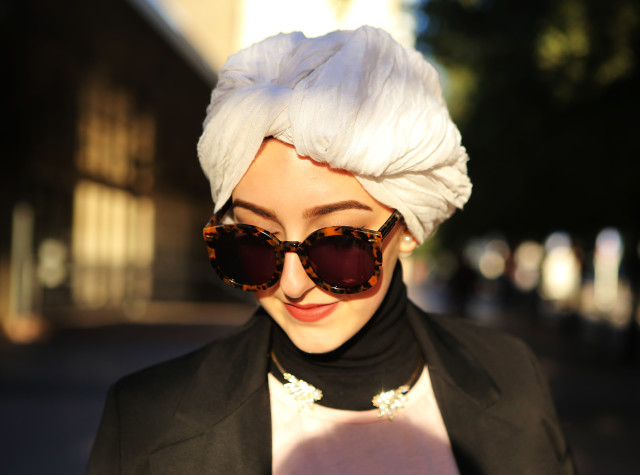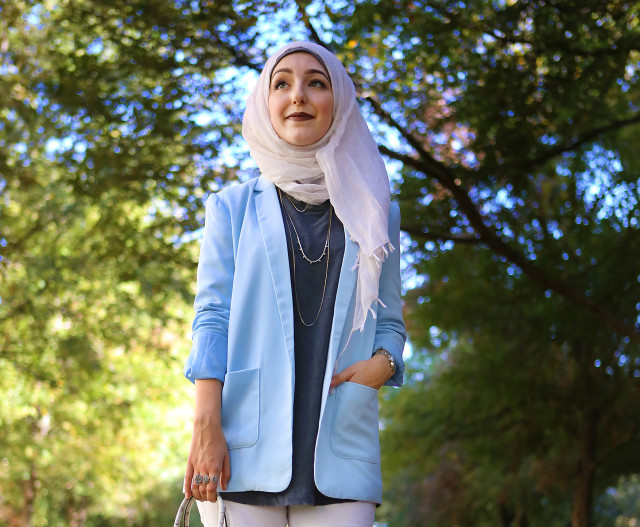Young Designers Turn Muslim Modesty Into Modern Fashion
By Faria Akram
Reporting Texas and the Austin American-Statesman
Dania Abdi knows a ton about fashion, though she struggles with her own.
“My first thought every morning is, ‘I have nothing to wear,’” said Abdi, 22, a textiles and apparel design major at the University of Texas at Austin.
Abdi has spent several years working to earn a spot in the fashion world while staying within her practice of Islam. She’s a proponent of modest, but stylish, clothing, a rapidly growing market worldwide.
Abdi wears the hijab, a head covering worn by many Muslim women. The hijab is part of the code of modesty that is a tenet of the Islamic faith, said Leena Asad, a 21-year-old fashion blogger from Tyler. Women who wear the hijab cover their hair, arms and legs.
Major clothing companies have turned their attention to this market. Sweden-based global retailer H&M featured its first hijab-wearing model in a September ad. Designers Donna Karan and Tommy Hilfiger have shown Ramadan collections featuring long-sleeved gowns and high-necked tops.
Abdi has interned with Texas designers, coordinated fashion shows in Austin and assisted in New York Fashion Week three years in a row. Her Instagram account, which has 6,000 followers, features long cardigans, statement necklaces, dark lipsticks and a variety of headscarves.
Modest dress is a centuries-long Muslim tradition, but high-style modesty has become more popular with the rise of social media, particularly YouTube. Muslim fashion celebrities such as Dina Torkia and Amenakin, both British, posted videos showing outfits and scarves that are fashionable and modest. As their followers grew in number, so did support and creativity from other Muslim women.

Dania Abdi models her take on the traditional Muslim hijab in downtown Austin. Cori Baker/Reporting Texas
“When I first wore hijab, I would just wear my mom’s old scarves,” said former modest-clothing designer Zeena Alkurdi, 26, who is now in marketing in Dallas. “I never really thought that I could have my own style and could make this look that I see at Forever 21 on the mannequin work for me.”
In 2012 and 2013, Alkurdi and her friend, Ndaa Hassan, 25, introduced Fashion for Compassion, a charity modest-fashion show in Dallas. The first show attracted more than 200 people.
“Our goal was to inspire creativity and inspire Muslim girls — that just because you wear hijab and are modest doesn’t mean you can’t be fashionable, too,” Alkurdi said.
Alkurdi says modest clothing gives women an expressive outlet. “When you dress modestly, you wear more. All that means is more opportunity for creativity and accessorizing,” she said.
“Long sleeves, long loose garments, maxi-dresses, trouser pants, they’re all seen now as chic and the new ‘it,’” Hassan said. “It’s not about how much you show and expose. It’s about people realizing how much Muslim shoppers are putting toward these brands, and they want to be able to cater to them.”
Designing modest fashion might be a business, but Abdi says the trend also has a positive impact on those who choose to dress modestly.
“I think it’s great either way for girls who shop at H&M and at Mango to see modest clothing,” Abdi said. “It’s nice for people who don’t know Muslims to see that and be like, ‘Hey, we have those similarities. I’m just like you, we’re not so different.’”
Modest clothing styles aren’t limited to Muslim women who cover their hair. Hamdiya Akbar, 20, an advertising major at UT-Austin, wears clothes that cover her shoulders and legs, but she chooses to not hide her hair.
“Modesty has different meanings for everyone,” Akbar said. “Some think it’s wearing a face covering. Some think it’s covering the entire body. It’s different for every person.”
Akbar’s style focuses on balance. She often pairs high waisted pants with shirts that are longer in the back, and adds jackets and blazers to her ensembles. Though she says coordinating outfits can be challenging, she sees a bigger benefit in choosing to dress the way she does.
“Being modest is being yourself and expressing your individuality, and you’re not forced into any fashion sense because you’re able to make your own up,” Akbar said.
It also adds a sense of freedom, says Alkurdi.
“Fashion is art,” she said. “It’s a way to express yourself, to be creative and tell the world this is me. These are the colors and prints I like, this is a way for me to cover myself and respect the laws that God has set out for me.”

